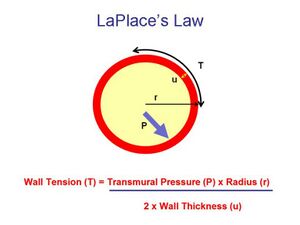31. Ventricular wall tension and the Laplace relationship
As explained in the previous topic, the tension in the ventricular wall is directly related to the ventricle’s oxygen requirement. When the wall tension increases, the oxygen requirement increases too.
LaPlace’s law

LaPlace’s law describes the relationship of pressure, radius of the lumen, the thickness of the wall and the wall tension in hollow organs like the ventricles and blood vessels.
LaPlace’s law is important in the heart because it explains how multiple pathological conditions increase the oxygen requirement of the heart. For example:
- When a ventricle is dilated the radius of it increases, which increases the tension
- When a ventricle is thickened the wall thickness increases, which decreases tension
- When the afterload increases the transmural pressure increases, which increases tension
These pathologies are relevant in pathophysiology and pathology, so they’re not very important for physiology.
